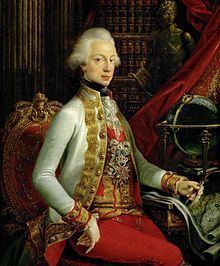Name Ferdinand Grand | ||
 | ||
Reign 22 July 1790 – 3 August 1801 Reign 11 February 1803 – 26 December 1805 Successor Francis I of Austria(as Duke of Salzburg) Children Leopold II, Grand Duke of Tuscany, Maria Theresa of Austria Parents Maria Luisa of Spain, Leopold II, Holy Roman Emperor Siblings Francis II, Holy Roman Emperor Similar People Leopold II - Holy Roman E, Ferdinand I of the Two Sicilies, Francis II - Holy Roman E, Maria Luisa of Spain, Maria Carolina of Austria | ||
Ferdinand III (German: Ferdinand Josef Johann Baptist; Italian: Ferdinando Giuseppe Giovanni Baptista; English: Ferdinand Joseph John Baptist; 6 May 1769 – 18 June 1824) was Grand Duke of Tuscany from 1790 to 1801 and, after a period of disenfranchisement, again from 1814 to 1824. He was also the Prince-elector and Grand Duke of Salzburg (1803–1805) and Grand Duke of Würzburg (1805–1814).
Contents
Biography
Ferdinand was born in Florence, Tuscany, into the House of Habsburg-Lorraine. He was the second son of Leopold, then Grand-Duke of Tuscany, and his wife Infanta Maria Luisa of Spain. When his father was elected Emperor of the Holy Roman Empire, Ferdinand succeeded him as Grand Duke of Tuscany, officially taking the office on 22 July 1790.
In 1792 during the French Revolution, Ferdinand became the first monarch to recognize the new French First Republic formally, and he attempted to work peacefully with it. As the French Revolutionary Wars commenced, however, the rulers of Britain and Russia persuaded him to join their side in the War of the First Coalition. Ferdinand provided his allies with passive support but no enthusiasm, and after he witnessed a year of resounding victories by the French, he became the first member of the coalition to give up. In a proclamation dated 1 March 1795, he abandoned the alliance and declared Tuscany's neutrality in the war.
His normalization of relations with France helped stabilize his rule for several years but by 1799 he was compelled to flee to Vienna for protection when republicans established a new government in Florence. He was forced to renounce his throne by the Treaty of Aranjuez (1801): Napoleon brushed him aside to make way for the Kingdom of Etruria, created as compensation for the Bourbon Dukes of Parma, dispossessed by the Peace of Lunéville in that same year.
Ferdinand was compensated with the Electorate of Salzburg, the secularized former territory of the Archbishopric of Salzburg He was also made a Prince-elector of the Holy Roman Empire (a role which expired with the Empire's dissolution in 1806), receiving the title and land on 26 December 1802, .
On 25 December 1805, Ferdinand had to give up Salzburg as well, which by the Treaty of Pressburg was annexed by his older brother, Emperor Francis II. Ferdinand was then made Duke of Würzburg, a new state created for him from the old Bishopric of Würzburg, while remaining an Elector. With the dissolution of the Empire in 1806, he took the new title of Grand Duke of Würzburg.
On 30 May 1814, after Napoleon's fall, Ferdinand was restored as Grand Duke of Tuscany.
Ferdinand died in 1824 in Florence and was succeeded by his son Leopold.
Family and children
In Naples on 15 August 1790 by proxy and in Vienna on 19 September 1790 in person, Ferdinand married firstly his double first cousin, the Princess (later Grand Duchess) Luisa of Naples and Sicily (1773-1802), daughter of Ferdinand I of the Two Sicilies and Maria Carolina of Austria.
Their children were:
Their first two children, Carolina and Francesco, died at very young ages (eight and five respectively) but the later three prospered under their father's care. Grand Duchess Luisa died when they were all quite young, on 19 September 1802, together with a stillborn son who was unnamed. Two decades later, in Florence on 6 May 1821, Ferdinand married again, this time to the much younger Princess Maria Ferdinanda of Saxony (1796-1865). She was the daughter of Maximilian, Prince of Saxony, and his wife Caroline of Bourbon-Parma; she was also his first cousin once removed, as well as the first cousin once removed of the dead Luisa. Though Ferdinand was likely hoping to produce another male heir, there were no children born of this second marriage.
